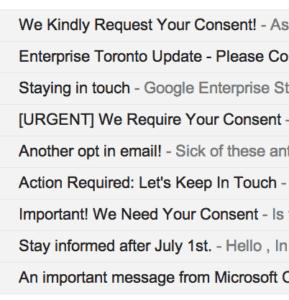 If you are an email marketer or a company from Canada, you have most likely been hearing lots about the CASL. As of yesterday, July 1st, 2014 the Canadian Anti-Spam Legislation (CASL) has come into effect. More strict than our southern neighbours CAN-SPAM, the CASL is here to “protect” Canadians from email spam.
If you are an email marketer or a company from Canada, you have most likely been hearing lots about the CASL. As of yesterday, July 1st, 2014 the Canadian Anti-Spam Legislation (CASL) has come into effect. More strict than our southern neighbours CAN-SPAM, the CASL is here to “protect” Canadians from email spam.
Please keep in mind that I am not a lawyer. Do not consider any of this post as legal advice or guidance. If you have questions about the legal implications CASL will have on your business, you should consult a lawyer. I have posted some links to more detailed sources at the bottom if you in learning more about how the laws will affect you.
First things first, the CASL does not only apply to Canadians or businesses operating in Canada, it also applies to anyone sending a “commercial electronic message” to a Canadian. It’s not just emails either, the CASL also includes text messages (sms) & instant messages.
The general rule is that CASL requires that you get explicit consent before sending a message to someone. This means no more emailing everyone who dropped a business card in your fish bowl draw at a recent trade show.
In the past few weeks leading up to the CASL launch yesterday, marketers have scrambled to figure out how to handle it. This is the main reason, why if you have an inbox that looks anything like mine, it’s filled with messages titled “We need your permission for CASL” or “CASL Update”. The ironic thing is, that this anti-spam legislation has caused a surge of unwanted emails. I’m not off the hook either, as I sent an update alerting subscribers of the change. A quick email with hopeful outcome of clicking the “I Confirm” has been the default from what I’ve seen. An unsubscribe button has also been prominent on most emails. I received little engagement on my CASL Update campaign. And even though nobody hit “unsubscribe”, only a small percentage actually to the time to click confirm. I can also add that of all the emails I received about the CASL update, I only clicked confirm on a small percentage. Not because I wasn’t interested in what the emails had to say, but just out of sheer laziness. Nobody wants to go out of their way to confirm AGAIN on an email list they have been on for years, even if it was originally implied consent.
If you received an email pre-CASL (July 1) that adds you to a list that falls through a loophole. Anyone on the email list from before July only needs implied consent for a grace period of 36 months. It’s only contacts added to an email marketing list after July 1st that need to have Express consent until 2017. So just because you didn’t confirm your willingness to receive the marketing emails, doesn’t mean you won’t be getting from them. At least for the next few years.
Resources